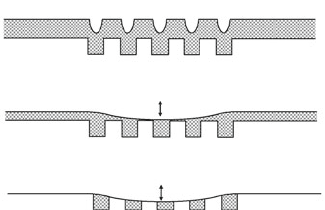Ghodssi R., Lin P., MEMS Materials and Processes Handbook
Подождите немного. Документ загружается.


1014 P. Lin e t al.
features include ease of handling during use and in waste disposal, long-term stabil-
ity, and low sensitivity to pattern density and line width effects (which may vary by
up to 5 orders of magnitude in different patterned areas on a single wafer).
CMP slurries can be generally categorized into two groups: dielectric slurries
and metal slurries. The most commonly used dielectric thin film in IC and MEMS
processing is silicon oxide. Slurries for oxide CMP processes have been devel-
oped from those used in the optical industry, in which silicate glasses must be
finely polished to fabricate optical devices such as lenses and mirrors. Normally,
oxide slurries consist of a colloidal suspension of fine fumed silica particles with
chemical additives for pH adjustment, typically KOH or NH
4
OH. Researchers
have also concentrated their efforts on developing ceria-based oxide slurries. Ceria
interacts chemically with oxide at a higher rate than silicon oxide does, and thus
ceria slurries are able to produce high material removal rates with low abrasive
content.
Metal slurries typically contain abrasive particles such as silica, and a number
of chemical additives such as oxidizers (H
2
O
2
, Fe(CN)
3
), inhibitors, complexing
agents, surfactants, and polymer additives. As the minimum feature size shrinks, the
tolerance for CMP defects drops dramatically. Since hard abrasives like silica can be
a significant source of defects and dielectric loss due to the aggressive mechanical
abrasion, researchers have investigated so-called “hybrid abrasive systems,” i.e. the
incorporation of silica with flexible polymer particles [229]. Pure polymer particles
are also intensively studied as potential replacements for conventional inorganic
abrasives [230].
Table 13.12 summarizes the effect of slurry variables on CMP performance. This
information can be used as a reference when a slurry must be tuned to meet specific
performance requirements.
Table 13.12 Effect of slurry variables on CMP performance
Slurry variables Effect
pH Dissolution rate of the surface being polished or polishing debris;
stability of the abrasive suspension
Buffering agents Prevent pH drifting
Oxidizers Induce reduction-oxidation reaction on substrate (metals), leading
to metal dissolution or surface film formation
Complexing agents Enhance dissolution of the surface (metals) being polished or
polishing debris
Viscosity Transport of abrasive and chemicals to and from wafer surface
Slurry abrasive type Abrasion models
Slurry abrasive size Removal rate, surface quality (scratches)
Slurry abrasive hardness Removal rate, surface quality
Slurry abrasive
concentration
Removal rate
Slurry stability Abrasive agglomeration, surface damage
13 Surface Treatment and Planarization 1015
13.7.3.1 Summary of Slurry and Pad
In order to meet specific requirements for MEMS and microelectronic fabrication,
commercial suppliers of slurries and pads have developed various dedicated prod-
ucts. Normally, slurries optimized for use in microelectronics manufacturing can be
adopted for use in MEMS CMP. However, due to the different wafer structures and
materials, these slurries cannot generally be used as-is in MEMS fabrication. Further
optimization is required to adapt slurries designed for use in microelectronics man-
ufacturing for use in MEMS. Pads used in MEMS fabrication, meanwhile, are
essentially the same as those used in microelectronics manufacturing. Table 13.13
lists some information about commercial slurries and pads used in MEMS polishing.
13.7.4 Polishing Considerations for Different Materials
The main concerns in CMP processes are polishing rate, planarization capabil-
ity, within die non-uniformity, within-wafer non-uniformity, wafer-to-wafer non-
uniformity, removal selectivity, defects, and contamination. Though some of these
issues, such as defect control, are common to all CMP processes, each CMP pro-
cess also has specific issues. In general, CMP processes in MEMS fabrication can
be grouped into three areas: dielectrics (including semiconductors), metals, and
polymers. In this section, major considerations for each of these materials will be
discussed.
13.7.4.1 Rate Comparison and Selectivity
In many CMP applications, it is desirable that material removal should continue
only until a certain interface has been reached, at which point the process should
stop. Therefore, a crucial consideration in slurry development is the differential
removal rate for the target and underlying layers. For example, in copper polishing,
an important interfacial concern is erosion: removal of the supporting inter-layer
dielectric (ILD) after the barrier layer has been removed [231]. Erosion is depen-
dent on ILD polishing rate, barrier removal rate selectivity, pattern density, and pad
hardness. As shown in Fig. 13.58, features with high pattern density are under high
local pressure due to the reduced supporting area for the polishing force. Therefore,
smaller features experience a higher material removal rate. Consequently, increased
ILD exposure time leads to erosion [231]. Erosion can be minimized by improving
slurry selectivity; with enhanced selectivity, the polishing process can effectively
stop when the ILD layer has been reached. CMP processes with endpoint detec-
tion can also reduce erosion by sensing that the ILD layer has been exposed, either
through changes in polishing table current or through optical signals [232]. Endpoint
detection systems improve process control, combatting variations such as pad-to-
pad variations, slurry instability, and pad wear. Erosion in other metal polishing
processes, such as tungsten CMP, has also been studied [233].

1016 P. Lin e t al.
Table 13.13 Pads and slurries for CMP in microfabrication [228]
Material Pads References Slurries References Remarks
Si-oxides
(SiO
2
, TEOS,
PETEOS, doped
oxides)
IC1000
TM
Series,
Politex
TM
Prima
Rohm and Haas Klebosol
R
1501-50,
Klebosol
R
1508-50
Rohm and Haas
EP-MD-8052,
EP-MD-8073
EP-MD-8080,
EP-MD-8090
Cabot
Microelectronics
Fumed silica, for
stack heights ≤
1 μm; colloidal
silica, for larger
stack heights
Planerlite-4000 Series Fujimi
Levasil 50CK/30%, Levasil
50CN/30%, Levasil
100 K/30%
H.C. Starck
SS 25 from Cabot Fraunhofer ISIT
SiN Suba
TM
500,
Politex
TM
Regular
Rohm and Haas Nalco
R
2360 Rohm and Haas
Al
2
O
3
MH Series Rohm and Haas Eminess UltraSol
TM
M5D4
(main)
Eminess UltraSol
TM
500
(final)
Rohm and Haas
Sapphire IC1000
TM
Perforated,
Suba
TM
1250,
Politex
TM
Regular
Rohm and Haas 6 μm/3 μm diamond (1),
1 μm diamond (2),
UltraSol 500 (3)
Rohm and Haas
SiC IC1000
TM
Perforated,
Suba
TM
1250,
Politex
TM
Rohm and Haas Nalco 2360 Rohm and Haas

13 Surface Treatment and Planarization 1017
Table 13.13 (continued)
Material Pads References Slurries References Remarks
Silicon Suba Series, SPM
pads
Fraunhofer ISIT Glanzox series Fujimi
Fixed abrasive pads VTT, 3 M Levasil 50/50%, Levasil
100/45%, Levasil
200/30%-WALM
H.C. Starck
Polysilicon IC1000
TM
Series,
Politex
TM
Prima,
WWP3
Rohm and Haas Klebosol
R
PL 1509-35,
Klebosol
R
PL 1509-12,
Klebosol
R
PL 1618
Rohm and Haas
SS 25 from Cabot Fraunhofer ISIT
Planerlite-6000 Series Fujimi
EP-MP-8010, EP-MP-8188 Cabot
Microelectronics
for stack heights ≤
1 μm
for larger stack
height removal
Germanium Suba
TM
X,
Politex
TM
embossed
Rohm and Haas Nalco
R
2360 Rohm and Haas
SiGe Politex
TM
Regular,
SPM3100
Rohm and Haas Levasil 50CK/30%-V1,
Levasil 50CK/30%-V2
H.C.Starck Abrasive for metal
slurry formulation

1018 P. Lin e t al.
Table 13.13 (continued)
Material Pads References Slurries References Remarks
Copper IC1000
TM
Series,
VisionPad
TM
Series, Politex
TM
Prima
Rohm and Haas EPL2361 Rohm and Haas
EP-MH-870, EP-MH-883
EP-MM-8042,
EP-MM-8043
Cabot
Microelectronics
for stack height ≤
5 μm
for stack heights ≥5
μm
Planerlite-7000 Series Fujimi
iCue
R
Slurries from Cabot Fraunhofer ISIT
Tantalum, TaN, TiN IC1000
TM
Series,
Politex
TM
Regular
Rohm and Haas CUS Series, LK Series,
SSA Series
Rohm and Haas
Tungsten IC1000
TM
Series,
Politex
TM
Series,
FBP Series
Rohm and Haas e.g. W2000 from Cabot Fraunhofer ISIT
NiFe IC1000
TM
Series,
Politex
TM
Prima,
WWP3000
Rohm and Haas MSW1500/2000 Rohm and Haas
ZnCu IC1000
TM
Series Rohm and Haas MSW1500 Rohm and Haas
Compol Series Fujimi
Levasil 50/50%, Levasil
100/45%
H.C. Starck Abrasive for slurry
formulation

13 Surface Treatment and Planarization 1019
Table 13.13 (continued)
Material Pads References Slurries References Remarks
AlN Suba
TM
500 Rohm and Haas Nalco
R
2370 Rohm and Haas
GaAs Suba
TM
X
embossed,
Suba
TM
500,
OPC6350,
SPM3100
Rohm and Haas Nalco
R
2360 Rohm and Haas
InP Suba
TM
500,
Suba
TM
X,
SPM3100
Rohm and Haas Nalco
R
2360 w/bleach Rohm and Haas
LiNbO
3
Suba
TM
1250,
Politex
TM
embossed
Rohm and Haas
Glass MH Series, Suba
TM
X, GS
Rohm and Haas Ceria based (main),
Nalco
R
2360 (final)
Rohm and Haas
Polyimide EP-MI-8005, EP-MI-8006 Cabot
Microelectronics
alumina based slurry
alumina based, low
defects
Reprinted with permission. Copyright 2007 John Wiley & Sons Inc

1020 P. Lin e t al.
Δh
SiO
2
Δh
Cu
c
b
a
Δh
SiO
2
Δh
SiO
2
Δh
Cu
Δh
Cu
c
b
a
Fig. 13.58 (a) Regions of low and high copper pattern density (PD); (b) copper polishes faster in
regions of high PD, so the copper in those regions is cleared first; (c) consequently, the underlying
dielectric layer SiO
2
receives more polishing time in regions of high PD and therefore experiences
more erosion [231]. Reprinted with permission. Copyright 1994 ECS
13.7.4.2 Dielectrics
As an enabling technology for lithography, etching and metallization, oxide CMP
is the most commonly used and studied CMP process [208]. In order to improve
interconnect reliability and yields, global planarization must be achieved in oxide
CMP. In addition to the improvements in lithography, oxide global planarization
also assists in the subsequent etching of the contacts and vias. Global planarization
depends mainly on underlying feature density. A number of studies of oxide CMP
have investigated the effect of the pattern density on global planarization efficiency
[234–236]. CMP process variables and consumables were each found to have a sig-
nificant effect on global planarity. Process parameters that affected global planarity
included platen speed, downward force, and carrier speed [234]. Properties of con-
sumables such as pad hardness and fluid dynamics also affected global planarity
[235, 236].
Bulk oxide polishing, such as ILD CMP, does not involve a material interface
as a stopping layer. Therefore, within wafer non-uniformity is solely dependent
on removal rate controls in the CMP process, tool, and consumables. In general,
within wafer non-uniformity is determined by non-uniformities in the removal rate
and in the film thickness. On the die scale, the removal uniformity depends on pat-
tern density, while on the wafer scale, the edge effect has a large impact on the
uniformity, as the wafer size increases from 150 to 200–300 mm [237, 238]. It is
possible to manipulate the CMP removal rate distribution to compensate for the
known non-uniformity of the wafer.
Another concern in oxide CMP is the presence of defects. The most com-
mon defect associated with oxide CMP is scratching [239]. Scratches can result
from pad/wafer contact, abrasive particle/wafer contact, and wafer handling errors.
Depending on the size and depth of the scratch, such a defect might cause various
failures, including shorting between adjacent lines if metal fills in a wide scratch.
Buff CMP processes are used to reduce scratches on the wafer. In buff CMP, wafers
are typically polished under low stress on a soft pad to remove small amounts of

13 Surface Treatment and Planarization 1021
oxide, helping to remove the sharp edges associated with a scratch. Although buff
CMP can improve yields by smoothing scratches, it cannot be used to repair deep
scratches. Therefore, the best option to avoid yield loss caused by scratching is
to eliminate the source of defects from CMP processes and consumables. Another
common source of defects in oxide CMP is contamination of wafer surfaces by par-
ticles or chemical contaminants during the CMP process. Post-CMP cleaning can
be performed to remove these contaminants from wafers.
13.7.4.3 Metals
Tungsten CMP and copper CMP are currently the mainstream fabrication techniques
for metal interconnect structures in semiconductor devices. Tungsten intercon-
nects can be divided into two categories: contacts, which serve as the interconnect
between the front-end of the device and back-end metallization, and vias, which
connect metal layers, as shown in Fig. 13.59. In order to overcome the high
resistance associated with decreasing metal line size, copper is introduced due to
its low resistivity to replace the conventionally-used aluminum in metallization.
Conceptually, tungsten plug fabrication and copper damascene are quite similar.
Figure 13.60 shows the process of forming copper lines and vias using the dam-
ascene technique. Specifically, oxide is etched to form the patterns for wires and
lines. A barrier layer is deposited to enhance the adhesion of the metal line and to
avoid the diffusion of copper ions into the underlying dielectric layer. Copper is then
deposited, and the overburden of copper is removed with CMP. In both tungsten and
copper CMP, the two main interfacial concerns are dishing and erosion.
Fig. 13.59 Cross-sectional
SEM image of a
representative tungsten plug
between two metal lines
[240]. Reprinted with
permission. Copyright 2004
CMP MIC

1022 P. Lin e t al.
Fig. 13.60 Damascene and dual damascene technology
In tungsten CMP, dishing refers to the removal of tungsten inside the via below
the ILD surface, while in copper CMP dishing refers to the removal of copper in the
trench below the ILD surface. In either case, erosion is the removal of material from
the supporting ILD after clearing the barrier layer [231]. Figure 13.61 illustrates
the differences between dishing and erosion in copper CMP. Dishing is dependent
on line width [231], copper removal rate selectivity, and pad hardness. At large
feature size, high copper removal rate selectivity for barrier or dielectric increases

13 Surface Treatment and Planarization 1023
Fig. 13.61 Schematic diagram of dishing and erosion in copper CMP
the dishing rate. Softer pads allow the force to penetrate into the trench, which also
leads to dishing. As mentioned in 13.7.4.1, erosion is highly dependent on pattern
density, removal selectivity, and pad hardness.
13.7.4.4 Polymers
In order to minimize interconnection delays, various polymeric low-k dielectric
materials have been introduced in microelectronics [241]. In MEMS fabrication,
a wide range of polymeric materials has been used depending on the specific
application. For example, polycarbonate (PC) and polyimide (PI) are often used
in biomedical devices due to their suitable interface with biological tissues [242].
Polymethyl methacrylate (PMMA) substrates are used to fabricate microfluidic
devices with an inprinting technique [243]. Global planarization is required on the
polymeric layer. The major challenge for the planarization of low-k dielectrics and
other polymers is their inferior mechanical strength and hardness as compared with
silica. This directly affects the CMP process because force and rotation rate must
be reduced to avoid mechanical damage and scratching. Requirements on slurry
chemistry are quite specific to the polymer substrates, as they depend strongly on
the chemical properties of the material. Furthermore, control of large particles in
the slurry must be more restrictive, because large agglomerates can easily indent
polymers due to their soft nature [244].
13.7.5 Cleaning and Contamination Control
An inseparable part of the CMP process, post-CMP cleaning determines the final
defect level on the polished wafer, and thus significantly affects the yield. During
CMP, wafer surfaces exposed to the aggressive chemicals and pressures inherent
in the process are easily contaminated with polishing residues, trace metals, organic
additives, and so forth. Resulting modifications and damage to the wafer surface can
adversely affect the device’s properties and performance. For example, polishing
residue can cause patterning and/or deposition errors in subsequent processes. These
errors may lead to shorts and incomplete circuits in the interconnect. An effective
post-CMP cleaning process can minimize this type of fault, reducing the frequency
